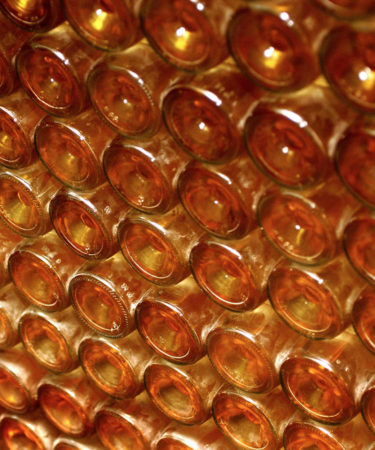We can’t totally count on continuity of climate these days, but basically, when it gets even a little bit warm, you’re bound to see a few bottles—then a full-on garden blossoming—of rosé at your local liquor store. The idea, as with Mallomars and (theoretically) oysters: it’s a seasonal treat, meant to be consumed with a lazier kind of attention, since you’re also half-focused on whether to let that last sandal fall off. (#Poolsidelivin’)
Not that rose isn’t to be taken seriously—there’ve been plenty of arguments made to the contrary. But we tend to drink (and associate) it with a lighter time, warmer months, preciously fleeting vacation days. And what we expect to drink is rosé from the prior harvest year, something young and casually sophisticated—like a college freshman reaching for depth in her first philosophy seminar.
And then fall comes. Temps (maybe?) drop. And the ingenue rosé wine of that year sits neglected on shelves, potentially to wait for some unwitting customer to purchase it the following year, despite an unapologetic lack of freshness. We’ve already asked the question—does freshness with rosé wine matter? (The answer, generally, yes.) But what about aging? Could you rescue one or two of the year’s rosés and bring them home for a year, even several?
Yes. But not always. The reason rosé tends not to age is because it’s generally produced for ultimate freshness, picked early, fermented at cooler temps with commercial yeast, aged in steel vats, most often skipping the softening step of malolactic fermentation (which rounds out some of that acidity). The goal is lively, fruity, fresh—all entirely desirable things, especially if you’re somewhere warm and breezy—but not necessarily age-worthy. The juice has no contact with oak and less contact with the seed and skin of red grapes, meaning age-friendly tannins are at a low. And while rosé does have higher acidity, which can make for a good storing wine, the structure of most “fresh” rosés isn’t sufficient to support the wine once that acidity falls flat (which could happen pretty rapidly as it ages).
So what is the exception to the rosé rule? The region of Provence; and specifically, within it, Bandol. Bandol may be best known for its powerful, super ageable reds, but what makes those reds so age-worthy is Bandol’s marquee Mourvèdre grape. Originally from Spain, Mourvèdre is a red grape that just doesn’t mess around: small clusters of fruit yield deep, inky purple wine which, at its youngest, is like a fist wound tight with powerful tannins and flavors like licorice, rich fruit, florals, minerality, even gaminess. Aging tends to soften tannins and uncurl these flavors, for the better. So when Mourvèdre is incorporated into a rosé (often blended with grapes like Cinsault and Grenache), that ageability passes on.
Bear in mind, Bandol rosés may age the best, but they’ll also cost the most—due simply to the high categorical quality of the rosé itself. A Bandol rosé might run you anywhere from $25 to $35 to more, but you may have a good shot at laying it down for 10 years or more. If you want something slightly less expensive, and maybe with a shorter shelf life (meaning you can sample your rosé-aging experiment sooner), regions Palette and Cassis produce rosés that could age as well in maybe half the time (Cassis for a few years, tops).
Tavel rosés are also fair candidates for aging, since they not only blend Mourvèdre in with the Syrah, Grenache, and Cinsault, but the winemakers tend to leave the skins in contact for longer, resulting in a deeper ruby color and imparting more tannic structure generally—and tannins help a wine chill out for a few years. And there are also exceptions to the rule; e.g. a Spanish Rioja rosé that’s been aged 10 years before even being released, so it’s done the work for you, but that’ll just cost you 50 bucks or so.
